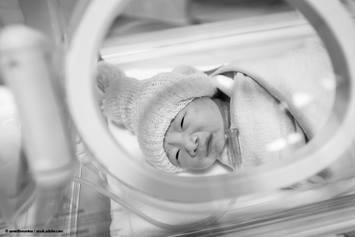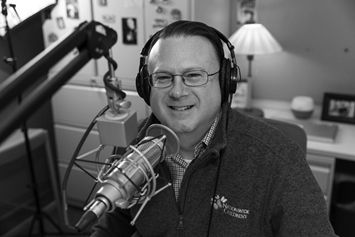Gastroesophageal Reflux
Some babies have more problems with their gastroesophageal reflux (chalasia or spitting up) than others, but most babies outgrow the problem by 12 months of age.
What Is Gastroesophageal Reflux?
Gastroesophageal reflux (chalasia or spitting up) is so common that it should be considered normal for babies. When babies swallow, their food goes from their mouth and into a tube called the esophagus. This tube carries the food into the stomach. A pressure zone called the lower esophageal sphincter at the bottom of the esophagus keeps food in the stomach from going back up into the esophagus. The sphincter is not as effective in infants, so some formula or food can come back up, causing the baby to spit up. Some babies have more problems with their reflux than others, but most babies outgrow the problem by 12 months of age. In some, it can last longer than this. Even if your child has a problem with reflux that requires treatment, he or she is still likely to outgrow their reflux.
What Symptoms Are Associated with Gastroesophageal Reflux?
Gastroesophageal reflux can cause heartburn (esophagitis, inflammation of the esophagus) which may make the baby fussy. However, not all irritability or fussiness in babies with reflux is cause by reflux, and treatment may not improve it.
Infants with gastroesophageal reflux may not gain weight well because:
-
They have been given too little formula in a well-meaning attempt to decrease vomiting.
-
They vomit too much of their formula.
-
They don’t eat enough because of pain (heartburn) from the reflux.
Babies with gastroesophageal reflux may also have breathing problems. They may have wheezing or pneumonia from getting food in their lungs when they spit up. They may also have apnea (periods when they stop breathing). These problems are rare and may not be due to reflux, even in babies with both problems.
How Is Gastroesophageal Reflux Diagnosed?
Diagnosis of gastroesophageal reflux is made by taking a medical history and physical exam. Testing is not usually needed. Some of the following tests may be done if your child doesn’t respond to treatment or if your doctor or nurse practitioner is concerned that something else may be going on.
-
Upper GI- During an upper GI, the baby swallows barium from a bottle. The barium coats the esophagus and stomach and makes it show up on the x-ray. It is a good way to make sure that there is no blockage causing the vomiting. It is often normal in babies with reflux, because they may not spit up during the test. On the other hand, an upper GI can show reflux in babies who don’t have significant reflux if it occurs during the five minutes of the test.
-
Chalasia scan- A marker, which shows up on x-ray film, is mixed with formula and swallowed. The baby then lies in front of a camera for a period of time to see if he spits up. A chalasia scan also looks for food that may have gotten into the lungs from reflux.
-
pH Probe- A pH probe is used to quantify gastroesophageal reflux. A small tube is placed through the baby’s nose and down into the esophagus. A small sensor on the end of the probe detects acid when the child refluxes. The parents can push a button for markers when the baby is having symptoms so the doctor can see if they correlate with reflux. The pH probe lasts for 18-24 hours.
-
Ultrasound- Looks for pyloric stenosis (a thickening of the muscle that keeps the stomach from emptying) or other abnormalities which can cause vomiting such as pancreas, liver, or kidney problems.
-
Swallow study- The baby eats and drinks in front of an x-ray camera. This test looks to see if some of the food is going into the lungs as the baby drinks or eats.
When Does Gastroesophageal Reflux Require Treatment in Infants?
Most babies with gastroesophageal reflux do not require treatment and will outgrow the reflux. If your child is having one of the following complications, your doctor or nurse practitioner may consider treatment for your infant.
-
Breathing Problems (wheezing, pneumonia, apnea)
-
Trouble gaining weight
-
Heartburn
Therapy is designed to treat the complication and usually does not stop the infant from spitting up. The baby will need time to outgrow the spitting up.
What Medicines Are Used to Treat Reflux in Infants?
There are three types of medicines to treat reflux.
-
Medicines to reduce the amount of acid made by the stomach
-
Medicines to help things move more quickly through the stomach
-
Medicines to protect sore areas of the esophagus and stomach
Medications to Reduce Acid:
- Antacids- Antacids can be added to the baby’s bottle. They are very effective in treating acid. Their main problem is that they need to be given frequently and can cause diarrhea. Examples include Maalox and Mylanta.
- H2 Blockers- H2 blockers prevent acid from being made. They have been in use for a number of years and have few side effects. High doses are tolerated well. Their main problems include bad taste and a somewhat higher cost. Examples include Zantac (Ranitidine), Pepcid (Famotidine), Axid (Nizatidine) and Tagamet (Cimetidine)
-
Proton Pump Inhibitors (PPIs) - Proton pump inhibitors also prevent acid from being made. They are strong especially when taken as an unopened capsule by older children and adults. In liquid form, the effects can be harder to predict. They are also expensive and the liquid tastes bad. Examples include Prilosec (Omeprazole), and Prevacid (Lansoprazole), Protonix (Pantoprazole), Nexium (Esomeprazole), and Aciphex (Rabeprazole). Not all of these are made as a liquid.
Medicines to Improve Motility (The Way Things Move Through the Esophagus, Stomach and Intestines):
- These medicines get food through faster so the baby spits up less. They may make some babies irritable. Reglan (Metoclopramide) and Erythromycin are the most frequently used medicines in this group.
Medicines to Protect Irritated Tissue:
-
Medicines like Carafate (Sucralfate) bind to sore areas and help them heal. It works very well, but it must be given an hour before eating and one to two hours away from all other medicines. It can also cause constipation.
- Antacids also protect sore areas. They can be given with food.
What Other Treatments Are Considered for Babies with Severe Reflux?
Formula can be dripped into the stomach or intestine with a tube. This can allow babies with severe reflux to grow while they are waiting to outgrow their reflux.
Does My Child Need Surgery for Their Reflux?
Most children do not need surgery for their reflux since there is a very good chance that they will outgrow it. Children with other medical problems are less likely to outgrow their reflux and more likely to need more treatment or to need surgery.
What Can I Expect with My Infant’s Reflux?
Thickening the formula or placing antacids in the bottle can often treat mild reflux. It also helps to hold your baby upright for 30 to 60 minutes after he/she eats. Placing the baby in a car seat or swing after eating may make the reflux worse. If the baby slides down and bends at the waist, the pressure on the abdomen could cause reflux.
If your baby is having more severe problems, he may need medicine to reduce the amount of acid produced by the stomach. Another kind of medicine helps food move more quickly out of the stomach and into the intestine. Formula with more calories in it may be suggested.
Your baby’s treatment will be designed to help relieve the symptom that was causing them the most problems (irritability, poor growth, or breathing problems). Most babies will still spit up while getting treatment. The vomiting will need time to go away.
Your child’s vomiting is likely to get worse when he/she is sick for other reasons. Most children will also have good and bad days.



